Bee venom-loaded EGFR-targeting peptide-coupled chitosan nanoparticles for effective therapy of hepatocellular carcinoma by inhibiting EGFR-mediated MEK/ERK pathway
- PMID: 35947632
- PMCID: PMC9365195
- DOI: 10.1371/journal.pone.0272776
Bee venom-loaded EGFR-targeting peptide-coupled chitosan nanoparticles for effective therapy of hepatocellular carcinoma by inhibiting EGFR-mediated MEK/ERK pathway
Retraction in
-
Retraction: Bee venom-loaded EGFR-targeting peptide-coupled chitosan nanoparticles for effective therapy of hepatocellular carcinoma by inhibiting EGFR-mediated MEK/ERK pathway.PLoS One. 2023 Jun 23;18(6):e0287805. doi: 10.1371/journal.pone.0287805. eCollection 2023. PLoS One. 2023. PMID: 37352224 Free PMC article. No abstract available.
Abstract
Hepatocellular carcinoma (HCC) is one of the world's most risky diseases due to the lack of clear and cost-effective therapeutic targets. Currently, the toxicity of conventional chemotherapeutic medications and the development of multidrug resistance is driving research into targeted therapies. The nano-biomedical field's potential for developing an effective therapeutic nano-sized drug delivery system is viewed as a significant pharmaceutical trend for the encapsulation and release of numerous anticancer therapies. In this regard, current research is centered on the creation of biodegradable chitosan nanoparticles (CSNPs) for the selective and sustained release of bee venom into liver cancer cells. Furthermore, surface modification with polyethylene glycol (PEG) and GE11 peptide-conjugated bee venom-CSNPs allows for the targeting of EGFR-overexpressed liver cancer cells. A series of in vitro and in vivo cellular analyses were used to investigate the antitumor effects and mechanisms of targeted bee venom-CSNPs. Targeted bee venom-CSNPs, in particular, were found to have higher cytotoxicity against HepG2 cells than SMMC-7721 cells, as well as stronger cellular uptake and a substantial reduction in cell migration, leading to improved cancer suppression. It also promotes cancer cell death in EGFR overexpressed HepG2 cells by boosting reactive oxygen species, activating mitochondria-dependent pathways, inhibiting EGFR-stimulated MEK/ERK pathway, and elevating p38-MAPK in comparison to native bee venom. In hepatocellular carcinoma (HCC)-induced mice, it has anti-cancer properties against tumor tissue. It also improved liver function and architecture without causing any noticeable toxic side effects, as well as inhibiting tumor growth by activating the apoptotic pathway. The design of this cancer-targeted nanoparticle establishes GE11-bee venom-CSNPs as a potential chemotherapeutic treatment for EGFR over-expressed malignancies. Finally, our work elucidates the molecular mechanism underlying the anticancer selectivity of targeted bee venom-CSNPs and outlines therapeutic strategies to target liver cancer.
Conflict of interest statement
The authors have declared that no competing interests exist.
Figures

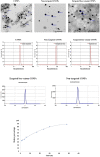


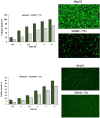
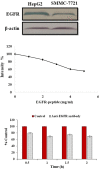

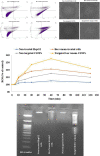
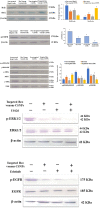


Similar articles
-
Retraction: Bee venom-loaded EGFR-targeting peptide-coupled chitosan nanoparticles for effective therapy of hepatocellular carcinoma by inhibiting EGFR-mediated MEK/ERK pathway.PLoS One. 2023 Jun 23;18(6):e0287805. doi: 10.1371/journal.pone.0287805. eCollection 2023. PLoS One. 2023. PMID: 37352224 Free PMC article. No abstract available.
-
GE11 peptide conjugated selenium nanoparticles for EGFR targeted oridonin delivery to achieve enhanced anticancer efficacy by inhibiting EGFR-mediated PI3K/AKT and Ras/Raf/MEK/ERK pathways.Drug Deliv. 2017 Nov;24(1):1549-1564. doi: 10.1080/10717544.2017.1386729. Drug Deliv. 2017. PMID: 29019267 Free PMC article.
-
Functionalized siRNA-chitosan nanoformulations promote triple-negative breast cancer cell death via blocking the miRNA-21/AKT/ERK signaling axis: in-silico and in vitro studies.Naunyn Schmiedebergs Arch Pharmacol. 2024 Sep;397(9):6941-6962. doi: 10.1007/s00210-024-03068-w. Epub 2024 Apr 9. Naunyn Schmiedebergs Arch Pharmacol. 2024. PMID: 38592437 Free PMC article.
-
Bee Venom Components as Therapeutic Tools against Prostate Cancer.Toxins (Basel). 2021 May 7;13(5):337. doi: 10.3390/toxins13050337. Toxins (Basel). 2021. PMID: 34067049 Free PMC article. Review.
-
An Updated Review Summarizing the Anticancer Efficacy of Melittin from Bee Venom in Several Models of Human Cancers.Nutrients. 2023 Jul 12;15(14):3111. doi: 10.3390/nu15143111. Nutrients. 2023. PMID: 37513529 Free PMC article. Review.
Cited by
-
Chitosan-Based Nanoparticles as Effective Drug Delivery Systems-A review.Molecules. 2023 Feb 18;28(4):1963. doi: 10.3390/molecules28041963. Molecules. 2023. PMID: 36838951 Free PMC article. Review.
-
Retraction: Bee venom-loaded EGFR-targeting peptide-coupled chitosan nanoparticles for effective therapy of hepatocellular carcinoma by inhibiting EGFR-mediated MEK/ERK pathway.PLoS One. 2023 Jun 23;18(6):e0287805. doi: 10.1371/journal.pone.0287805. eCollection 2023. PLoS One. 2023. PMID: 37352224 Free PMC article. No abstract available.
-
NanoFlora: Unveiling the therapeutic potential of Ipomoea aquatica nanoparticles.J Genet Eng Biotechnol. 2025 Mar;23(1):100470. doi: 10.1016/j.jgeb.2025.100470. Epub 2025 Feb 28. J Genet Eng Biotechnol. 2025. PMID: 40074444 Free PMC article.
-
Synthesis and characterization of honey bee venom-loaded calcium oxide nanocomposites and evaluation of their cytotoxic (MCF-7) and antifungal activity.Discov Nano. 2025 Jul 31;20(1):125. doi: 10.1186/s11671-025-04322-7. Discov Nano. 2025. PMID: 40745502 Free PMC article.
-
Targeting Dysregulated Ion Channels in Liver Tumors with Venom Peptides.Mol Cancer Ther. 2024 Feb 1;23(2):139-147. doi: 10.1158/1535-7163.MCT-23-0256. Mol Cancer Ther. 2024. PMID: 38015557 Free PMC article. Review.
References
Publication types
MeSH terms
Substances
LinkOut - more resources
Full Text Sources
Medical
Research Materials
Miscellaneous

